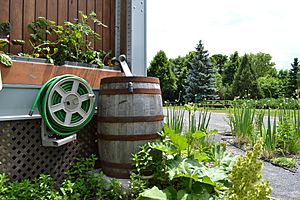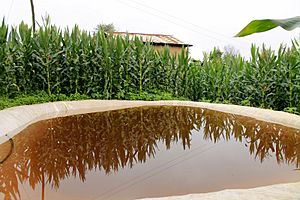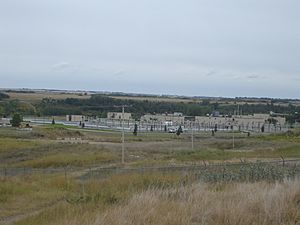Rainwater harvesting in Canada facts for kids
Rainwater harvesting is a way of collecting and storing rain that falls from the sky. Many Canadians are starting to use this method in their daily lives. Rainwater can be used for many things. It helps reduce stormwater runoff and can be used for watering gardens. People also use it for laundry and flushing toilets.
Collecting rainwater is not expensive. It is very helpful for watering plants and gardens. More and more Canadians are setting up systems to collect rainwater. These systems help manage stormwater, water plants, and supply water for laundry and toilets. Rules about collecting rainwater exist at both provincial and local levels. Since the mid-2000s, Canadian laws have changed. This has made it easier to use rainwater harvesting in homes, farms, and businesses. However, some rules are still unclear in different provinces. Local city rules often guide how rainwater harvesting is done.
Many groups and companies in Canada help with rainwater harvesting. They offer education, technology, and installation services. Examples include the Canadian Association for Rainwater Management (CANARM) and the Canada Mortgage and Housing Corporation (CMHC). CANARM focuses on teaching and raising awareness for people interested in this field.
Contents
Rules for Collecting Rainwater
The National Plumbing Code allows collecting rainwater. You can use it for things like flushing toilets and watering outdoor plants. The right to collect and use rainwater depends on provincial governments and local city rules. However, most provinces do not have many specific laws about it. The rules about who owns captured rainwater are not always clear. They can be different for homes and businesses.
If you build a system to store rainwater, it must follow provincial and local rules. The Canada Mortgage and Housing Corporation (CMHC) has created guides. These guides help Canadians design and install rainwater systems correctly.
Provincial Rainwater Rules
Many provinces have few or no specific rules about rainwater. Below are provinces that do have some laws. However, many local cities have their own rules. These rules often cover how to collect and store rainwater.
Alberta
Alberta has guidelines for collecting rainwater at home. These guidelines help make sure systems are safe to design, build, and maintain. They offer more details than the current building codes. They also help systems meet the CAN/CSA 128.1 Design and Installation of Non-Potable Water Systems standard. The Alberta Building Code and National Plumbing Code rules are more important than these guidelines. There is also a handbook to help people understand the technical parts of the guidelines better.
British Columbia
In British Columbia, rainwater is seen as "common property." This means it belongs to everyone and no one until it is collected. Landowners do not own the water until they capture it. But, they can collect rainwater without limits. They do not need to worry about people downstream who also use water. Rainwater is not part of the Water Act's system for sharing water. The common law probably means that other users do not have a right to share rainwater equally.
Ontario
In Ontario, you can use rainwater for flushing toilets and urinals. You can also use it for underground irrigation systems. Many rules are in place for collecting, moving, and storing rainwater. These are found in the Ontario Guidelines for Residential Rainwater Harvesting Systems. Winter temperatures in Ontario often drop below freezing. So, there are strict rules to keep rainwater from freezing. Water in pipes must also be controlled to prevent freezing. This is done through draining and temperature controls. The guidelines also cover how to manage overflow, water pressure, and prevent water from flowing backward.
How Rainwater Harvesting is Used in Canada
Agriculture
In Canada, farmers do not widely use rainwater harvesting for watering crops. However, with more farmers practicing ecofarming, some have started using these systems. Farmers use the collected rainwater for watering their fields and providing water for their animals. Often, the collected water goes into a deep pit where it soaks into the ground.
Green Building Design (LEED)
Leadership in Energy and Environmental Design (LEED) is a system that rates how "green" a building is. It is recognized in 150 countries, including Canada. The Canada Green Building Council recognizes it. Buildings that use rainwater harvesting can earn points for LEED certification. These points are given for things like:
- Controlling stormwater to reduce runoff and pollution.
- Using rainwater efficiently for landscaping.
- Using new wastewater technologies for non-drinking uses like toilet flushing.
- Saving water to reduce the demand on city water systems.
- Using recycled materials for rainwater harvesting equipment.
Industry

Like in agriculture, rainwater harvesting is not very common in Canadian industries. If businesses use rainwater, they usually have a very large cistern. These cisterns can hold up to 40,000 litres of water. In the Greater Toronto Area, where winters are very cold, cisterns are placed in warm areas. These can be underground parking lots or basements. The Centre for Interactive Research on Sustainability at the University of British Columbia (UBC) uses rainwater. They use it for plumbing, heating, and cooling. We do not have exact numbers on how many businesses use rainwater harvesting.
Homes
Collecting rainwater at home is easy. You can place a tank under a downspout outside your house. Green roofs also use rainwater to water plants naturally. They also help cool the building and control moisture. In Canada, rules for rainwater harvesting and greywater reuse (water from laundry, showers, and sinks) are still being developed.
Benefits of Rainwater Harvesting
Positive Effects
In places where water is scarce, collecting rainwater can help. It reduces the need to use groundwater. It can also help refill groundwater supplies. During Canada's summer months, this practice can ease the pressure on city water systems. It is seen as a great "green" way to get water.
Rainwater harvesting could affect natural water flows and users downstream. The water cycle includes surface water, groundwater, and rainwater. If rainwater harvesting becomes very popular, it could significantly impact the water cycle. However, we still need more research to understand its full effects on a watershed.
Most of Canada has not faced water shortages yet. But, it is believed that climate change could make this more likely. For example, the Okanagan region in British Columbia already has water issues. Most of its surface water sources are limited by licenses. Because this area does not get much rain, more rainwater harvesting could mean less water for licensed users downstream.
Advantages
Rainwater harvesting helps protect natural water systems. It reduces paved areas and increases how much water soaks into the ground. It also lessens pollution from stormwater runoff. This practice can reduce the use of drinking water or other natural water sources. This is especially true for watering gardens. Rainwater harvesting also means less wastewater is produced. It reduces the demand for drinking water. Plus, it takes some pressure off city water supply and wastewater systems.





